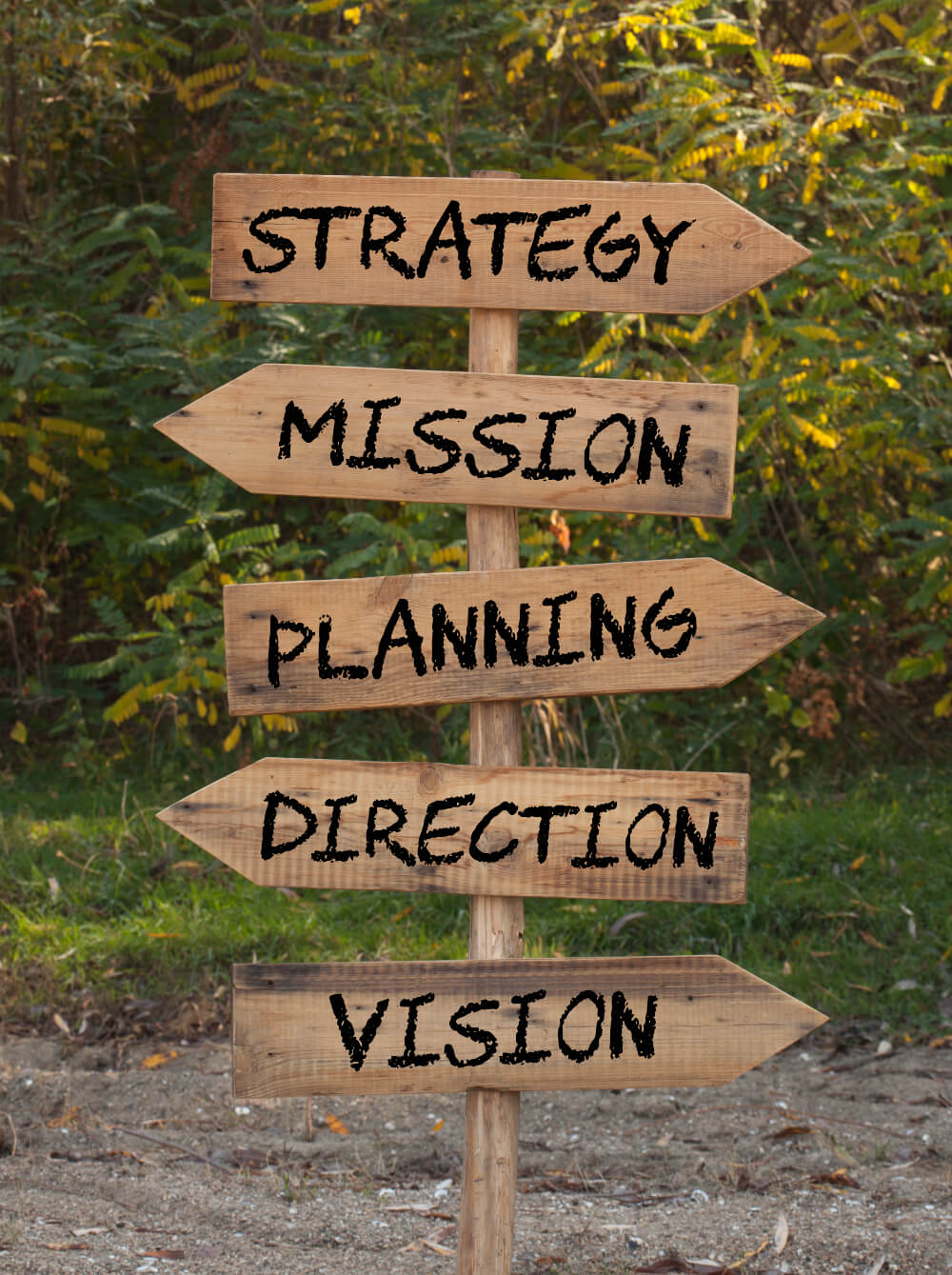In our work, we often discuss how important it is for a leader to define the vision. This then has folks asking how to create a vision statement and how it differs from a mission statement. So, let’s dive in...
What Is A Vision Statement?
It’s a future-focused statement that describes a company’s long-term goals. It’s aspirational and ambitious but not impossible. It says what your company hopes to achieve or become in the future. It provides direction and motivation for the organization’s activities and decisions. It speaks to why you do what you do. A vision statement is typically more internally focused (for employees and shareholders).

What Is A Mission Statement?
In contrast, a mission statement is focused on the present. It answers the “what” and the “how” of your organization. It’s usually more action-oriented and specific than a vision statement. Mission statements are public-facing and can drive company policies.
Mission Versus Vision
I always love to use the analogy of The Wizard of Oz when I teach goal-setting, and I think it works well for distinguishing between vision and mission too.
TO THE EMERALD CITY...
In the movie, Dorothy and her friends set out to see the Wizard in the Emerald City. They each long for something different (a heart, a brain, courage, a way home). The group is told they can get to the Emerald City by following the yellow brick road. The yellow brick road and the destination of the Emerald City is the mission - it answers how they will reach their goal and the actions they’re taking right now to get there.

The vision is what inspires them to keep going. It’s what they can achieve once they arrive at the Emerald City. For Dorothy, it’s a way home, for the Tinman, a heart, for the Scarecrow, a brain, and for the Cowardly Lion, courage. All is achievable by going to see the Wizard. And they use the shared, consistent vision of the Wizard to inspire and motivate each other along the way.
Here is an example from Disney to give you an idea of how they differ.
DISNEY'S vision statement is “to be one of the world’s leading producers and providers of entertainment and information.”
DISNEY'S mission statement is “to entertain, inform and inspire people around the globe through the power of unparalleled storytelling, reflecting the iconic brands, creative minds, and innovative technologies that make ours the world’s premier entertainment company.”
You can see that the vision is broad and ambitious while the mission dives into the “how” and is present focused.
Client-Oriented Vision
At one of my former client’s companies, they were focused on creating raving fans. Each and every step they took could be litmus tested. If it contributed to creating raving fans - super, that could be investigated further. And when an issue popped up that got in the way of creating raving fans, it was given top priority. This was easy and inspiring. They had conferences where fans were lauded and appreciated, clients participated in marketing campaigns, and often “sold” others on the company's greatness. It was clear the company took it seriously AND had fun.
Examples Of Client-Focused Vision Statements
NIKE - “to bring inspiration and innovation to every athlete in the world”

LINKEDIN - “to create economic opportunity for every member of the global workforce”
META - “giving people the power to build community and bring the world closer together”
Goal-Oriented Vision
Sometimes companies prefer to focus on achieving a certain goal. At another of my client’s organizations, the entire company rallied around the goal of finishing a huge antique schooner and putting it into the water. This initiative supported their vision “to re-imagine the interchange between maritime heritage and broader contemporary culture.”
Examples Of Goal-Oriented Vision Statements
STARBUCKS - "to establish Starbucks as the premier purveyor of the finest coffee in the world while maintaining our uncompromising principles while we grow.”

APPLE - “to make the best products on earth and to leave the world better than we found it.”
GOOGLE - “to provide access to the world’s information in one click.”THE HIVE
THE STRATEGIES YOU NEED TO SUCCEED
In-depth workbooks that walk you step-by-step through designing strategies tailored to your organization. Your remarkable results are waiting.
Adjusting Your Vision To The Times
Sometimes, the vision is a reaction to the market or environmental conditions. In one of my client’s organizations, sales have always been king. In a down economy, however, retaining clients has become equally important. So the organization has created a vision to give the client relationship team equal footing, billing, and air time so they can uplevel the expertise and tenure needed to serve and support their clients. This allows them to retain more clients while staying true to their mission of helping clients achieve their long-term investment goals.
Another example of this is when you look at the vision and mission of Southwest Airlines.
SOUTHWEST AIRLINE'S vision statement is “to be the world’s most-loved (client-focused), most efficient (goal-focused), and most profitable (goal-focused) airline.”

SOUTHWEST AIRLINE'S mission statement is “to connect people to what’s important in their lives through friendly, reliable, low-cost air travel.”
And the “low-cost air travel” was definitely driven by a market that saw skyrocketing airfares and plenty of hidden fees.
Questions To Guide You
If you’re creating a mission statement ask yourself…
- What do we do?
- Who do we serve?
- How do we serve them?
We’ve got more about writing mission statements over here.
If you’re creating a vision statement ask yourself…
- What are our hopes and dreams?
- What problem are we solving for the greater good?
- Who or what are we inspiring to change?
Share Your Vision
Once you’ve created a vision for your company, don’t forget to clearly communicate it using multiple channels such as company-wide meetings, email updates, or internal newsletters. Provide concrete examples of what your vision looks like in practice and ask for questions or feedback from employees and stakeholders. And make sure to reinforce your vision regularly so everyone is inspired, aligned, and working towards a common goal.

Your vision statement is like a light guiding you towards your long-term goals. It focuses on the future and where you want to be, while your mission statement explains what your organization is all about, what you do, and how you do it.
Remember, your vision statements should be adaptable as your organization evolves. Gather your team and craft a unique and inspiring vision that reflects your organization's values and goals.
If you’d like help with the design or facilitation of a vision statement, please reach out to us. Or learn more about our facilitation services here.


